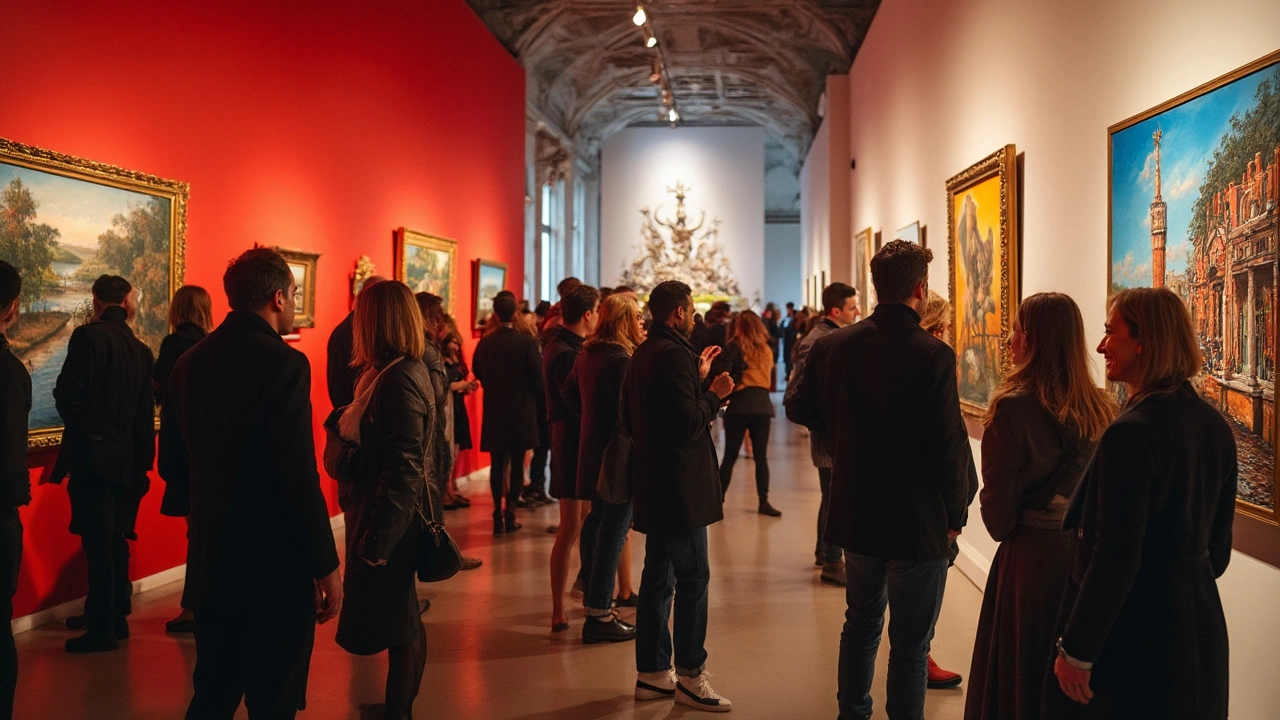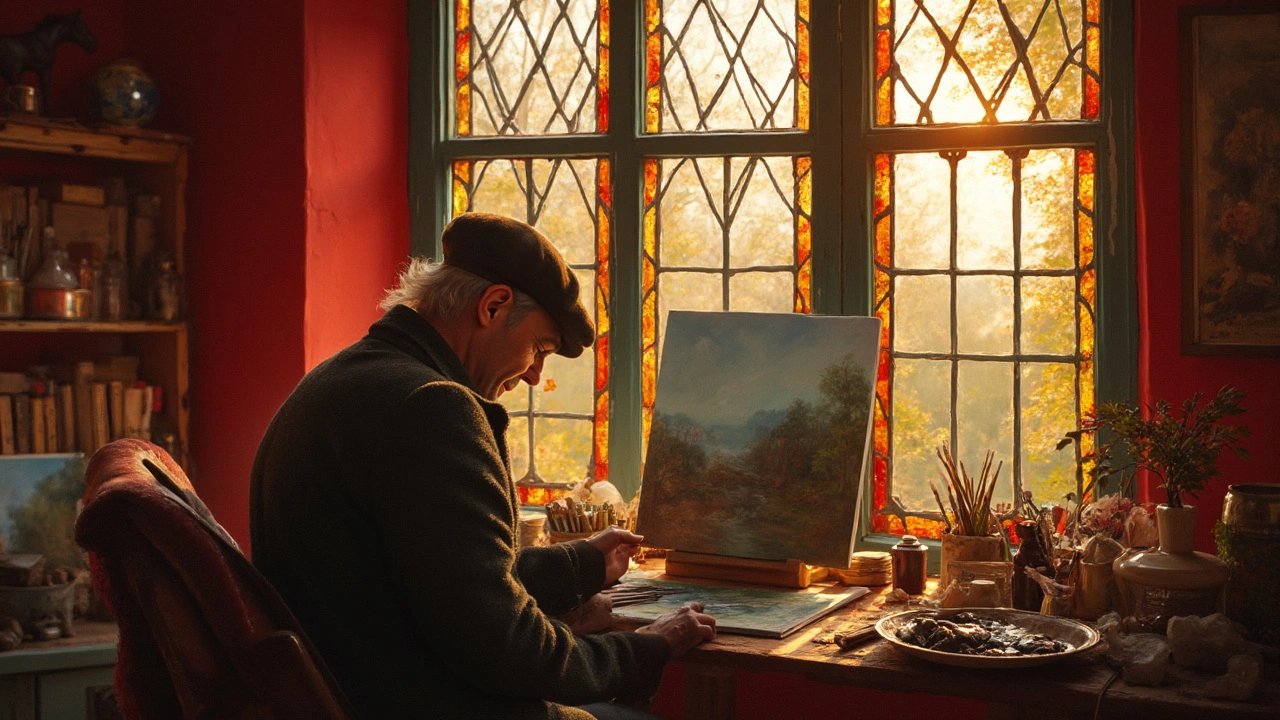Ever been curious why artists often slather a layer of red onto their blank canvases before getting down to the real painting? It’s not just about aesthetics. This trick of the trade has been used for ages, and there are some pretty neat reasons behind it.
First off, using a red base can really make colors pop. Think of it as adding a little zing right from the start. When you paint over red, your colors can come alive in ways they might not on a plain white background. This is because the red base alters how light interacts with the layers of paint laid over it, adding depth and warmth to the finished piece.
Not to mention, if you’re working on landscapes or portraitures, that red can sneakily help you map out shadows and highlights. It’s like having a secret guide that’s subtle but super helpful in building those rich, dynamic contrasts.
- The Science Behind Red Canvas
- Benefits of Using a Red Base
- How to Implement Red Canvas Technique
- Common Misunderstandings and Tips
The Science Behind Red Canvas
When it comes to painting on a red canvas, there's more going on than meets the eye. The magic isn't just in the color itself but in how it reacts with other colors laid on top.
How Colors Interact
Color theory plays a big role here. Red is a warm, vibrant color that can influence the tones above it. When you layer other colors on top, the red underneath subtly shifts their perception, giving them a certain warmth and vibrancy that might not be there otherwise.
Imagine painting a sunny landscape. The red base cheats the eye into seeing a warmer, more dynamic scene. This is because the red base reflects through the painted layers, affecting how they absorb and reflect surrounding light.
Creating Depth
The red background also helps in creating visual depth. Normally, a white canvas can reflect a lot of light through the paint, often making it look flat. With red, that reflection is toned down, giving more of a dimensional look.
Practical Benefits
There are also practical reasons for using a red canvas. It's easier to see the sketch outlines you draw on it, compared to a white one. Plus, any little bits of canvas that show through in the final product add a dynamic touch that artists love.
You don't have to go with a specific shade of red either. Some artists prefer a more orange base, while others might go for a deep crimson. The key is to find what complements your style best.
Benefits of Using a Red Base
Using a red canvas as a base is like giving your artwork a silent boost. One of the top perks? It adds a surprising vibrancy to your colors, making them appear more vivid and alive. This is especially noticeable with oil paints, where the underlying red can subtly shine through the layers, enhancing overall warmth.
Enhanced Color Contrast
Artists love the contrast that a red base provides. With it, darks appear deeper, and lights seem brighter. No extra effort needed. This pop of under-color can transform simple compositions into captivating images.
"The red base acts as a harmonizer, tying together varied hues in a composition," says renowned art critic, Linnea Sanderson.
Building Depth and Warmth
Red also naturally adds a sense of depth to paintings. With its warm undertones, it is particularly effective in providing believable skin tones in portrait work and creating rich shadows in landscapes.
Quick and Easy Outlining
Here's a nifty trick: a red base helps with outlining. When you leave fine red lines exposed, they can serve as distinct borders, creating crisp, clean edges effortlessly.
Practical Cost Effectiveness
Plus, using red can be a cost-effective choice. You end up using less paint on top layers because you don't need to pile it on to achieve brightness. Less paint, more savings.
All these painting tips make the red base not just a choice, but a strategic one for any serious artist looking to enrich their art effortlessly.

How to Implement Red Canvas Technique
Deciding to start with a red canvas is a bold move that sets the stage for your creative process. If you're curious about how to get started, you're in the right place.
Choosing the Right Red
Not all reds are created equal. You might want a warm, deep red like a burnt sienna or a brighter cadmium red. Generally, a middle-tone red works well, giving you both vibrancy and flexibility. Experiment to see which red works best with your style and palette.
Prepping Your Canvas
- First, grab your usual canvas. You can use this technique on any size, so don't be shy!
- Use a wide brush to apply the paint. You want an even coat, but it doesn't have to be perfect.
- Make sure the canvas is dry before you start painting your masterpiece over it.
By using a red base, you're giving yourself a rich background that will likely influence the entire feel of your oil painting.
Layering Your Paints
When you start painting over the red background, remember that the red will affect the first few layers. Transparent paints will let the red peek through, adding warmth. Opaque paints will cover it more but still gain a depth that’s hard to achieve on white.
Special Tips
- Try using a red canvas for portraiture, as it can naturally add life to skin tones.
- Play with contrast by using cooler colors to see how they stand out.
Consider this approach an extra tool in your painting toolkit. It’s an easy change with a big impact on your finished work! So roll up your sleeves and give the red canvas a shot.
Common Misunderstandings and Tips
When artists first hear about painting the canvas red, there's a wave of skepticism and a few common misconceptions that often pop up. Some folks think it's just an old-fashioned method that serves no real purpose in modern art, but that's far from the truth.
The Myth of Overpowering Red
One big misunderstanding is that the red canvas will overpower all the colors you layer on top. Artists might worry that their delicate blues or subtle yellows won't stand a chance against such a bold color. But in reality, this base actually helps those lighter shades stand out even more. It's like how a hint of salt enhances a dish—unexpected but effective.
Red Only for Warm-Toned Art
Another myth is that this technique only suits warm-toned or earthy paintings. While it's true that red can add warmth, it also brings out the best in cool tones, providing contrast that makes them appear brighter and more defined. So, whether you're working on a serene snowy landscape or a vibrant sunset, the red canvas does the trick.
Pro Tips for Using Red Canvas
If you're eager to try this out, here are a few tips:
- Primer First: Always start with a layer of primer. It'll help the red adhere better and create a smoother surface.
- Thin Layer: A thin, even coat of red is all you need. Too much can indeed overwhelm your paints.
- Experiment with Shades: Not all reds are the same. A burnt sienna or a deeper crimson might work better depending on your project's mood.
- Blend Wisely: When blending other paints, remember that the red can subtly alter the final tone, often for the better.
Is Red Canvas Right for You?
It's crucial to think about whether this fits your personal style and goals. Some artists like the control and clarity of a white base. The best way to know? Give it a spin. Trying out a red canvas on smaller projects can be a fun experiment without the commitment of a full piece. Who knows? It might just inspire your next masterpiece!

